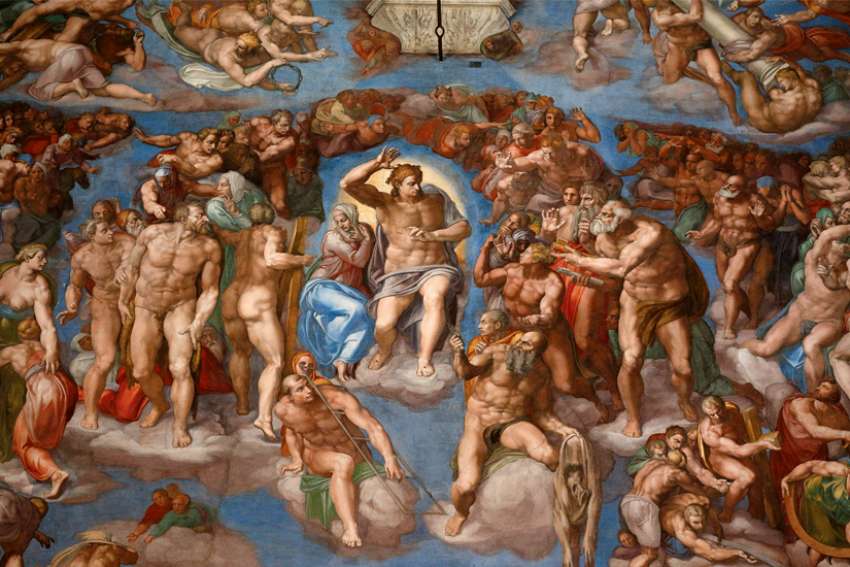He founded a library and collected the books.
-- 2 Maccabees 2:13
The Vatican Museums comprise 54 galleries of which the Sistine Chapel is undoubtedly the most famous. They exhibit more than 20,000 significant pieces of art, a mere fraction of the works in the collection of over 70,000. These include sculptures, paintings, maps and more, with the pièce de resistance being Michelangelo’s Volta della Cappella Sistina, a High Renaissance art masterpiece painted in only four years by the 33-year-old prodigy.
The large fresco on the sanctuary wall, entitled The Last Judgement, and the breathtaking The Creation of Adam painting, in which the index fingers of God and Adam are separated by an infinitesimal gap, are among the most famous paintings on the planet. The latter has featured in virtually every contemporary pop-culture moment of the 20th-century. One of the best-known is the poster to E.T. the extra-terrestrial, but some of my favourites include Scott Hilburn’s cartoon of two men contemplating the ceiling, which is rendered as a paint-by-number image. One says gravely, “Honestly, I think I may have cleaned it a little too well.”
The fame of the Sistine Chapel is all the more surprising when we remember that Michelangelo only reluctantly accepted the task, insisting that he was a sculptor and not a painter. He complained bitterly about the strain that painting the ceiling caused him, including in a mock-serious poem to this friend Giovanni da Pistoia that he had “grown a goiter from this torture.” Adding insult to injury, a mold attacked his first version so he had to chip away the plaster and start again, using specially designed scaffolding that allowed him to paint standing up. The agony must have been acute.
As famous as the Sistine Chapel is, another remarkable gallery, painted at the same time, is known as the Segnatura. It is one of the first rooms painted by the equally legendary Rafael. This was Pope Julius’ library and study and the image is famous for its reproduction of numerous figures from Greek history, including Plato and Aristotle. La Scuola di Atene, or the Athens School, also contains two rather remarkable details. One is a self-portrait of Rafael, but the other was a late addition. The story goes that Rafael snuck into the Sistine Chapel and saw Michelangelo’s work. He was so humbled by the young artist’s genius that he returned to his own painting and added an image of Michelangelo in the foreground dressed in 16th-century painter’s garb.
The effect of touring the Vatican galleries, or St. Peter’s Basilica and other treasures of the Holy See, has been described by some as causing Stendhal syndrome, also known as Florence syndrome. The condition describes the vertigo, dizziness and even hallucinations triggered by the vastness of human-generated art, rendered on a scale that can overwhelm the human senses.
Of all the galleries I have enjoyed over the years, the one that left me feeling speechless and overwhelmed was a modest (by Vatican standards) gallery tucked away behind the Apostolic Vatican Library. Simply known as the Library of Stone, it is dedicated to works literally carved in stone. The stone tablets are distributed throughout a majestic room, embedded into the walls themselves, so they become a type of inspired mosaic of a kind I haven’t really ever seen before — a braille that speaks to ages of mystery and erudition.
The wonders of the Vatican museums remind us of the enduring importance of art. As Pope Francis has pointed out, the world needs beauty. He urges us to frequent, or build, sacred spaces that are “oases of beauty,” that will foster “an encounter with God and communion with one’s brothers and sisters, thus becoming a reference for the growth of inhabitants, and for a harmonious and strong development of the community.” He identifies the important role of artists, “particularly of those who are believers,” to create works “that bring — through the language of beauty — a sign, a spark of hope and trust precisely where people seem to give in to indifference and ugliness.” He calls on all artists “to make beauty shine especially where darkness or drabness dominate everyday life.” Given the darkness we are witnessing in our world today, it is important to take a moment to remind ourselves of our capacity for good, manifested through our ability to create art and beauty.
Our commitment to good, like our faith, should be carved in stone.
(Turcotte is President and Vice-Chancellor at St. Mark’s and Corpus Christi College, University of British Columbia.)


